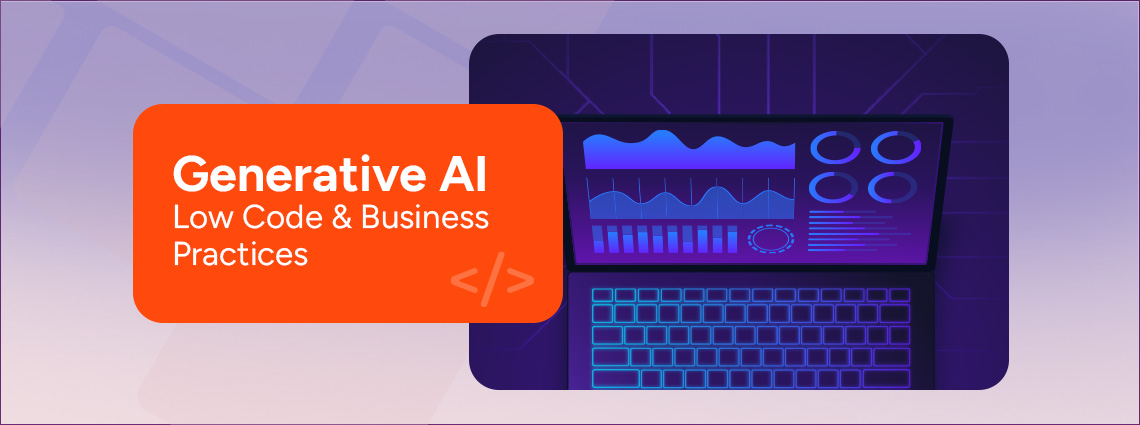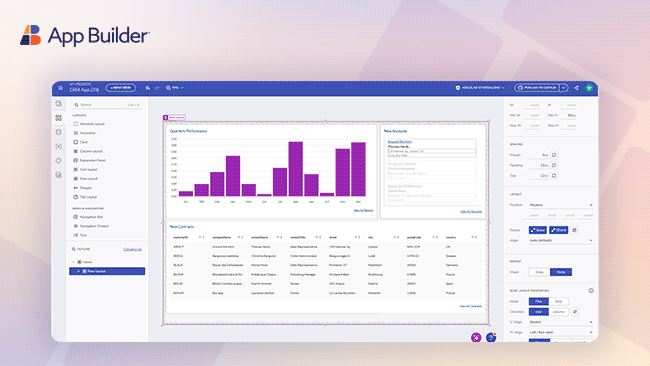

What Are the 5 Limitations of AI in Low-Code App Development?
As low-code app development tools continue to emerge, teams must quickly adapt to market changes and keep pace with the latest innovations, thus breaking old concepts with new approaches. From adopting agile methodologies to leveraging more automation solutions, development practices are constantly being refined to enhance productivity, deliver value more rapidly, and stay ahead of […]
As low-code app development tools continue to emerge, teams must quickly adapt to market changes and keep pace with the latest innovations, thus breaking old concepts with new approaches. From adopting agile methodologies to leveraging more automation solutions, development practices are constantly being refined to enhance productivity, deliver value more rapidly, and stay ahead of the curve.
There are now micro apps, super apps, and composable apps built with pioneering methods combining modern-day low-code platforms and generative AI. Tools like App Builder help teams deliver projects faster, shortening teams’ backlogs and reducing the need for highly skilled developers. However, as the industry’s focus is beginning to turn towards integrating artificial intelligence into these tools, it’s essential to consider the limitations and challenges that accompany this transition.
Let’s delve deeper to explore what’s low-code development, the limitations of AI in low code, and the top 5 challenges that come with it.
The App Development Reinventor – Low-Code Platforms
What is low-code app development? In essence, it is the process of crafting full-featured apps for any framework using low-code platforms. To address many of the hurdles and bottlenecks that today’s app development teams face, these tools arrive with a set of capabilities that automate everything behind app building—from design to code.

Low-code development platforms offer many features designed to streamline the development process and enhance productivity. These platforms provide a user-friendly, drag-and-drop app building experience combined with high-speed rapid application development (RAD). They include a visual integrated development environment (IDE) for defining user interfaces, data models, workflows, and more, making it easier for developers to create complex apps without extensive manual coding.
A key advantage of low-code platforms is their comprehensive toolbox of reusable UI components for Angular, Blazor, and Web Components. Additionally, these platforms offer a design system that adheres to an inventory of UX patterns and brand style guidelines, ensuring that the applications function well and provide a consistent UX. Instant code generation and real-time code preview capabilities are also significant features of low-code platforms. These enable developers to see changes immediately, facilitating faster iteration.
Apart from these key points, other significant benefits that low-code tools like App Builder provide teams with include:
- Lowering entry barriers for application development so people of different skill levels can create fully functional apps.
- Extensive customization options, including theming, branding, styling, and advanced features to tailor applications to specific needs.
- Connectors for various back-ends and services, ability to add external data sources and securely bind them to the applications, and support for Open API, facilitating seamless integration with other systems.
- Speed of app creation with an application lifecycle manager to support building, debugging, deploying, and maintaining apps throughout testing, staging, and production.
- The ability to start projects from scratch, convert design files into pixel-perfect applications, accelerate the development process, or experiment cost-effectively with minimal effort.
- Ready-to-use templates, starter layouts, and sample apps to jumpstart projects.
- Data analytics capabilities and business intelligence (BI) dashboards to provide valuable insights and aid in decision-making.
- Integrated AI functionalities that allow for quick and easy generation of data sources, images, themes, views from image prototypes, and so forth.

It is no surprise when, in their “Large Enterprises Succeeding with Low Code” Report, Forrester indicates that “91% of IT and business decision-makers responsible for digital transformation initiatives at enterprises in the US, the UK, Canada, and Australia use low code to improve existing IT capabilities to promote agility and innovation.”

And in Gartner’s “Magic Quadrant for Enterprise Low-Code Application Platform,” low-code application development is expected to be responsible “for more than 65% of application development activity” this year. With these types of functionalities and accelerated workflows, low-code tools are redefining “outdated trends in app development. But what happens when you add AI to the picture?
AI Low Code: Understanding AI in Low Code
In summary, AI in low-code refers to the integration of artificial intelligence capabilities within low-code development platforms. This combination allows teams to leverage both technologies’ strengths, enhancing and speeding up the development process while reducing manual coding effort.
One example of the function of AI in low code development is AI-assisted programming, where AI analyzes user inputs and then generates code snippets, workflows, or entire apps. AI algorithms allow repetitive tasks to be automated and completed much faster than traditional hand coding.
With AI-powered natural language processing (NLP) capabilities, users can easily describe what they want in plain language and define parameters. The AI-powered platform then quickly scans the data and translates these descriptions into functional code or components. This way, people with a limited technical background can actually build applications easily and with little assistance.
However, despite these advantages and practical scenarios, there are certain disadvantages, as already mentioned.
Let’s Discuss the Limitations of AI in Low-Code Development
When we think about AI, we typically think of critical factors and results like providing new ways for:
- Revolutionizing how tasks are automated.
- Generating code outputs with AI code assistants
- Improving business processes and solutions.
All this is thanks to its ability to understand and replicate patterns from vast datasets. Nevertheless, as the use of AI in app development continues to grow, it is not without certain limitations. For example, Gartner Survey reveals that “46% of CIOs are partnering with their CxO peers to bring IT and business area staff together to co-own digital delivery on an enterprise-wide scale”. While this democratization means saving time and development resources because the digital delivery of products and services is entrusted to non-technical teams, there are questions like what the technical consequences are that non-technical people can’t really foresee.
Here are other key challenges to consider:
- Developers Losing Control Over Their End Product
While AI-driven features aim to simplify the development process, the main concern for developers is they do not want to lose control over what they are building. With tools like App Builder, the differentiator is that we give the end user complete control and editable code. Anything you produce inside the platform is yours, fully customizable with the extensibility to export production-ready code for Angular, Blazor, Web Components, or others.
- Low-Quality, Non-Usable Code
The main advantage of low-code development tools is the ability to deliver production-ready, usable code. Here, we see another limitation in AI-generated code: It tends to focus on quantity rather than quality, bug-free code. This forces teams to sacrifice the long-term maintainability of their projects, hindering their ability to troubleshoot and debug any issues that arise quickly.
- Flexibility and Adaptability
Low-code platforms provide users with the flexibility to tailor applications to their specific requirements, incorporating custom business logic, integrations, and workflows. AI models, on the other hand, may need significant training and customization to generalize across diverse use cases or adapt to evolving requirements.
- User Experience and Control
While AI-driven features aim to simplify the development process, they struggle to balance automation and user control. Developers are pigeonholed to AI-generated suggestions that may not align with their vision or preferences despite describing certain parameters in the first place. This, in turn, removes the human element of app design, creating a lack of creativity and no longer fostering innovation.
- Security and Compliance
To ensure that apps built with AI models comply with industry standards and requirements, meticulous code quality assurance is required, which automated processes may not be able to provide. As a result, this could lead to compliance issues and code errors or vulnerabilities, potentially exposing the entire project to security risks and legal complications that are costly and time-consuming to resolve post-deployment.
Finding Common Ground
When comparing low-code app development to AI-driven approaches, it’s essential to recognize the complementary nature of these technologies. While low-code platforms offer a user-friendly environment for rapid app development, AI can augment these tools by automating certain tasks, enhancing design recommendations, and optimizing code generation. However, AI-generated code cannot always meet strict critical security and compliance requirements.
In conclusion, while AI presents exciting opportunities for enhancing low-code app development, it’s essential to approach its integration with caution, recognizing its limitations and challenges. By embracing a balanced approach that combines the strengths of low-code development with the potential of AI, organizations can unlock new levels of efficiency, innovation, and competitiveness in the ever-evolving landscape of app development.



